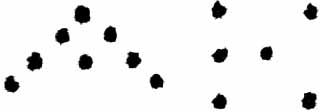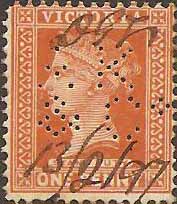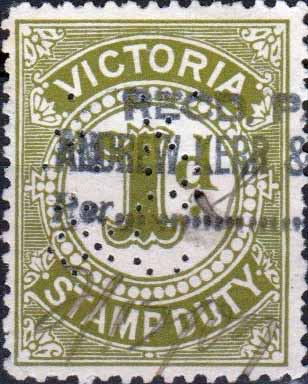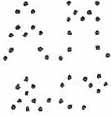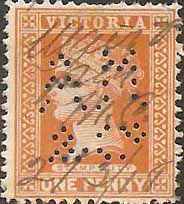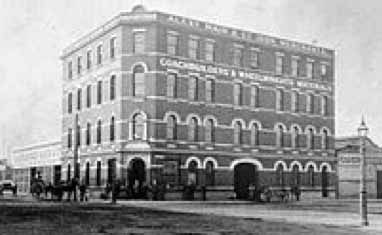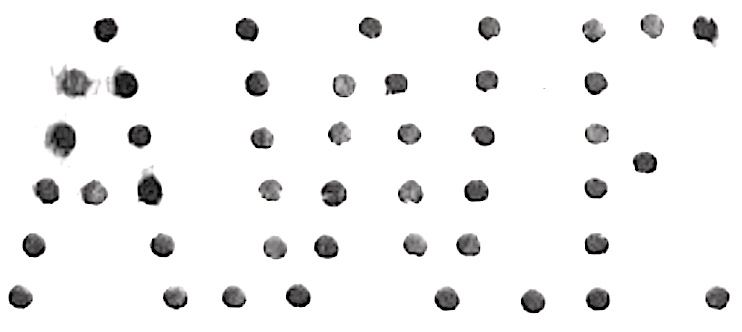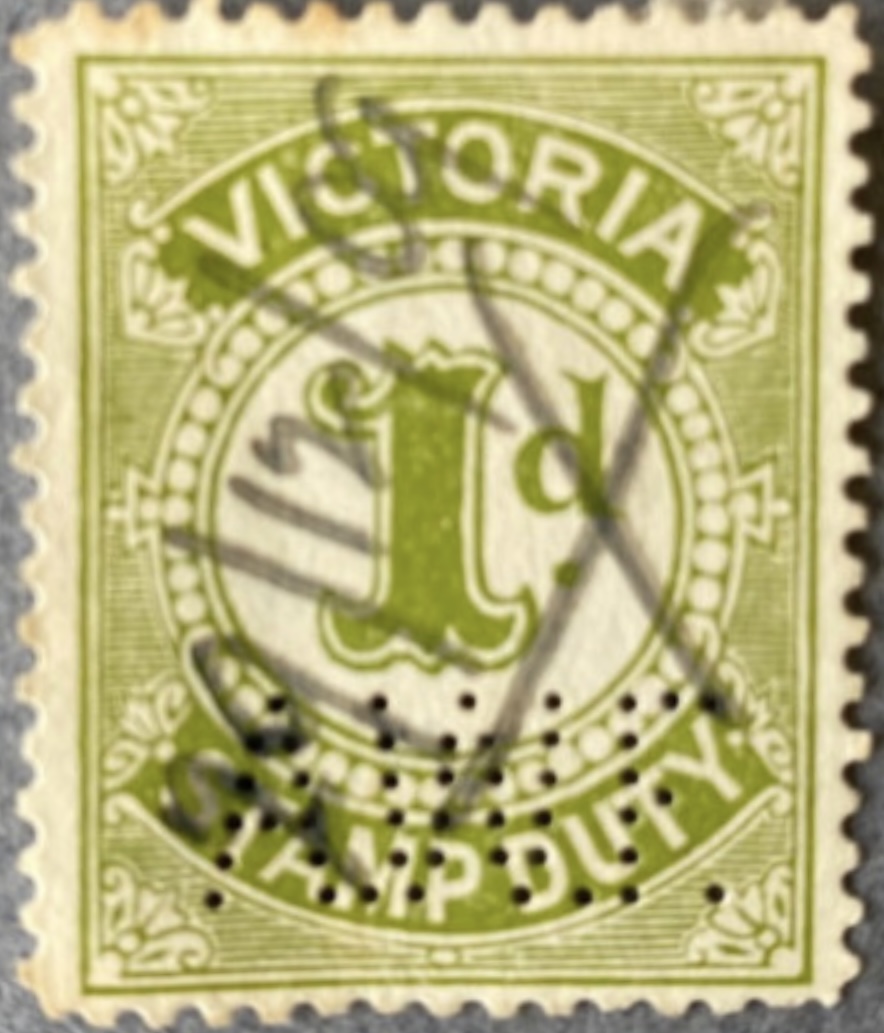|
Private Revenue Perfins of Victoria An Elsmore Coath production The authors would welcome your comments additions or input into this work A B C D E F G H I J K L M N O P Q R S T U V W Y Other A -------------------------------------------------------- AB.a
User: AB Address: St, Melbourne, VIC Revenue Use: 1886-1899 Series, inscribed 'STAMP DUTY' 1d (shades) Rarity Scale:
1886-1899 Series 1d R4
Background: Unknown
Device: The AB.a pattern is made from a temporary die in a single die format. Such devices, which could produce these temporary patterns, were used by some Stamp Vendors in Melbourne from late 1800’s and early part of the 20th Century. This AB.a pattern is known over the period 1897-99 and comes in a series of settings with the main difference being the separation of the two letters. It is most commonly found on postage stamps and only very rarely on revenues. Related Patterns: Nil --------------------------------------------------------
AE.a
User: Alfred Edments Retailer Address: 82 Bourke St, Melbourne, VIC Later: 309-311 Bourke St, Melbourne, VIC Revenue Use: 1902 Series 1d Rarity Scale:
1902 Series 1d R4
Background: * Alfred Edments was born on 17 October 1853 at Whitechapel, London, son of James Edments, labourer, and his wife Ann, née Lyons. After a brief schooling and employment with a cork merchant he sailed for Sydney in 1865 aged just 12 years old. He joined his brother James, a contractor at Cowra, but Alfred soon returned to Sydney and there he found employment with a wholesale drapery firm. In around 1869 he moved to Wellington, New Zealand, to manage a dairy-produce store. His time in Wellington was successful but in 1880 he returned to Sydney and became an auctioneer and commission agent in the firm of James Walker. In 1888 Alfred moved again, this time to Melbourne where he established himself as an auctioneer and then founded the Melbourne Supply Stores at 82 Bourke St, which was noted for its watches, clocks, jewellery, cutlery and fancy goods. Alfred’s expanded his stores to include several Melbourne suburbs and Geelong and later opened two shops in Hobart. In 1891 Alfred made the first of three overseas buying trips and established a buying office in London. He travelled through Europe and the US in search of novelties and later he employed a network of English and Continental buyers. His fancy goods business was the largest in Victoria and became one of the largest of its kind in the Commonwealth. On 15 September 1896 he married Annie Fennell and they made their home at Goodwood, Canterbury Rd, Surrey Hills. Alfred established his main Melbourne store at 309-311 Bourke Street in a three-storied spacious building about 1901. He believed in the principle of cash payment and in addition to his retail stores he conducted a cash mail order business as well as wholesale trading through special showrooms on the upper floors of his Bourke St location. Alfred was a generous employer and he distributed a proportion of profits half-yearly in the form of staff premiums, as well as giving holiday pay and in some cases wages as well as medical bills, were paid to staff that were ill. He made a substantial donation to the (Royal) Melbourne Hospital and his employees were obliged to contribute one penny each per week towards its support. Continual hard work caused Alfred’s health to deteriorate while he was still in his forties and, in the last nine months of his life, he managed his business from his home. On 13 July 1909, he died of heart disease, leaving an estate valued for probate at £107,594 and an enlightened will, which enabled his trustees to expand and continue his business. Alfred’s will appointed his wife Annie and Mr. F. G. Read executors and provided that his estate be allowed to accumulate for 20 years, or until the death of his wife. Thereafter, one-quarter of his estate was to be held in perpetuity for the benefit of charity. Under this management the company continued to expand establishing a store in Adelaide in 1916 and eventually leading to a network of 23 stores mainly in Melbourne. When Mrs. Annie Edments died, in 1928, the estate was valued at about £1,000,000, and the annual Income was £100,000, of which £25,000 went to charity. Later on the death of Mr. Read the estate came under the control of the Trustees Executors and Agency Co., Ltd., which formed the business into a proprietary company. The proprietary company traded until 1936 when the Trustees entered into negotiations with Woolworths Ltd which had been trading in Australia for 12 years and was mainly located in Sydney (20 stores) with stores in Queensland (8) and WA (2) as well as New Zealand. Woolworths eventually purchased a selection of sites and these were progressively rebranded as Woolworths. The sale did not include the free hold on the various Edments stores and these continued to be held by the trustees and sold in subsequent years. In July 1936 a new company Edments Ltd. Was formed and this company occupied four key Edments locations in Melbourne (Bourke St.), Geelong, Hobart, Adelaide and later expanded into Sydney, Launceston, Perth (1938) and Brisbane (1946). The company was later acquired by Angus & Coote but continued to trade as Edments in SA and WA until as recently as 2008. Device: The AE.a pattern is made from a temporary die in a single die format. Such devices, which could produce these temporary patterns, were used by some Stamp Vendors in Melbourne from late 1800’s and early part of the 20th Century. This particular pattern is found on postage stamps in about 9 different settings between 1907 and 1911, but only a single setting is reported on a revenue. Related Patterns:
VIC: AE.b
* https://adb.anu.edu.au/biography/edments-alfred-6089 -------------------------------------------------------- AE.b
User: Alfred Edments Retailer Address: 82 Bourke St, Melbourne, VIC Later: 309-311 Bourke St, Melbourne, VIC Revenue Use: 1902 Series 1d Rarity Scale:
1902 Series 1d R4
Background: See AE.a
Device: The AE.b pattern is made from a temporary die in a single die format. Such devices, which could produce these temporary patterns, were used by some Stamp Vendors in Melbourne from late 1800’s and early part of the 20th Century. This particular pattern is extremely rare on both postage and revenue stamps and due to its shape it was originally thought to be AK. This pattern is found used in 1909. Related Patterns:
VIC: AE.a -------------------------------------------------------- AK/&Co.a
User: Andrew Kerr & Co Ltd Timber Merchants Address: 42-66 Franklin St, Melbourne, VIC Revenue Use: 1886-1899 Series, inscribed 'STAMP DUTY' 1d (shades) Rarity Scale:
1886-1899 Series 1d R4
Background: The Company that was to become Andrew Kerr & Co Ltd was initially formed in the 1870’s (possibly earlier) as Halstead, Kerr, and Co., timber merchants.
It became Andrew Kerr and Co Ltd from 1888 (possibly earlier) and it was managed by Andrew Kerr until his premature death on a visit to London in March 1889.
Andrew Kerr (Junior) was born in 1886 and worked in the family business until joining the AIF during World War 1. He served in the 5th Division and was killed at Fromelles on 20 July 1916 aged 30. Mr. James Stuart McDonald who had been with the company since days of Halstead, Kerr, and Co. become Managing Director until 1920 when he became a Director of the Kauri Timber Co. Ltd.
Device: The AK/&Co.a pattern is not proved to the user Andrew Kerr and Co Ltd but AK/&Co.b is and these two patterns are part of a logical chronology of a single user.
There are a total of 5 AK/&Co patterns found on the postage stamps of Victoria but only 2 are found used on revenue stamps.
All the AK/&Co patterns are Temporary perfin patterns made by a Stamp Vendor. Although there are no known records of these Vendors in respect to specific patterns and users, proving pieces tend to support the view that the Vendors used a single alphabetic layout for each user so all AK/&Co patterns can be provisionally attributed to Andrew Kerr and Co Ltd.
The AK/&Co.a pattern is found used on the postage and revenue stamps of Victoria in the period in the period 1896 until 1901. The AK/&Co.b pattern is then found used from 1901 until about 1911.
Related Patterns: AK/&Co.b -------------------------------------------------------- AK/&Co.b
User: Andrew Kerr & Co Ltd Timber Merchants Address: 42-66 Franklin St, Melbourne, VIC Revenue Use: 1902 Series Rarity Scale:
1902 Series 1d R4
Background: See AK/&Co.a above
Device: See AK/&Co.a above. The AK/&Co.b pattern is found used on the postage and revenue stamps of Victoria in the period in the period 1901 until 1915. Related Patterns: AK/&Co.a -------------------------------------------------------- AM/&Co.a
User: Alex Mair & Co Timber, iron and steel merchants Address: Victoria St, Carlton, VIC Revenue Use: 1886-1899 Series, inscribed 'STAMP DUTY' 1d (shades) Rarity Scale:
1886-1899 Series 1d R4 Background: *The company of Alex Mair & Co was established in the late 1800’s. The company was an Iron, steel and timber merchant that was later involved in coach building, tyres, paints and varnishes and hardware. Alexander Mair Junior was born on 25 August 1889 at North Carlton, Melbourne, eldest child of Victorian-born parents Alexander Mair, ironmonger, and his wife Florence, née Hunter. Alexander was educated at Wesley College, and then after being apprenticed to a blacksmith at Thoona, near Wangaratta he returned to Melbourne to study commerce at Bradshaw's Business College and then went on to work in the family business. On his father's death in 1913 Alexander took over the family firm, which then expanded into hardware. He several times visited overseas suppliers, but a bout of influenza in the 1919 epidemic and subsequent asthma led him gradually to withdraw from business. In 1922 he sold the steelyard to Eliza Tinsley Pty Ltd and in 1925 the company's other assets to James McEwan & Co. Pty Ltd, serving as a director of the latter until 1927. He then retired to a country property, Rockwood near Albury, NSW From here he moved into politics and in 1932 he won the State seat of Albury for the United Australia Party (UAP). He was a capable back-bencher and promoted local issues, spending most of his time in his electorate, but retained his business links in both Melbourne and Sydney. In April 1938 Mair was appointed a joined cabinet as an assistant minister but 10 weeks later he became Minister for Labour and Industry but following the failed policies of his Premier and fellow Cabinet members’ leadership of the UAP fell to Mair, who was then sworn in as Premier on 5 August 1938.
Alexander Mair & Co. Offices on the corner of Victoria and Leicester Streets, Carlton, circa 1888. He lead the UAP in the early years of WW2 but he lost a May 1941 poll but he remained leader of the UAP until February 1944; in May of that year he held the seat of Albury as a Democratic candidate and in November 1945 he accepted leadership of the new Liberal Party but resigned in August 1946 to unsuccessfully contest the Federal Senate election leading to his retirement from politics. Mair returned to Rockwood, but later sold the property in 1948 and returned to Melbourne, where he accepted a number of Directorships, was elected to the boards of various charitable institutions, and became involved in horse-racing and the management of Scots Church. He died on 3 August 1969 at his St Kilda home. Device: The AM/CO.a pattern is made from a temporary die in a single die format. Such devices, which could produce these temporary patterns, were used by some Stamp Vendors in Melbourne from late 1800’s and early part of the 20th Century. There are three different AM/&CO patterns found on the postage stamps of Victoria and the pattern AM/&Co.a is the only one found on revenues. They are found used in 1898. Related Patterns: Nil
*Australian Dictionary of Biography *auspostalhistory.com *Wikipedia -------------------------------------------------------- A.W.F..a
User: Australian Widows Fund Life Assurance Society Life Assurance Address: 456 Collins St, Melbourne, VIC Revenue Use: 1902 Series Rarity Scale:
1902 Series 1d R4 Background: *The Australian Widows' Fund (AWF) Life Assurance Society commenced business in November 1871 and it was built on the mutual system, which means that the policy holders of the Society proportionally own the assets of the Society. The focus of the Society was the provision of Life cover, which is called life assurance, but it later expanded into Accident and Sickness cover.The Society was modeled on the Scottish Widows Fund Life Assurance Society, one of the largest and most successful Mutual offices in the world. The model was initially successful as the Mutual model generally meant lower premiums and higher returns. This encouraged other Mutual companies to emerge around the same time including, National Mutual Life (1869), Mutual Assurance Society of Victoria (1871), T&G Mutual Life Society Limited (1876), and Colonial Mutual Life Society (1877).
By the late 1800's the AWF had offices in Melbourne, Sydney, Adelaide, Brisbane, Launceston as well as Wellington (NZ).
Initially the company invested its weekly receipts into sound investments; however the land boom in Melbourne in the 1880’s saw growing land speculation. The high demand for land lead to a high demand for funds. Many Building Societies, Banks and Mutual Funds, such as the AWF, were drawn into the speculation by providing funds to developers on the basis of an Investment prospectus.
In the later part of 1891 an economic slump meant a reduction in demand and many land developments failed. In particular the Australian Widows Fund was effected by a loan of £30,000, which they had been made to the ‘West Melbourne Land Company’ under the personal guarantee of Benjamin J. Fink. Fink’s fortunes and those of his Company burst at the same time and he was able to pay only a halfpenny in the pound to his creditors.
The AWF applied to the Supreme Court on the grounds that their funds had been procured by fraud. The case was settled out of court, there being a satisfactory arrangement with the return of money to the AWF, but this action was not settled until 1895 and it was only one of many similar investments that the fund had made. In 1896 the AWF wrote off a total of £125,000 capital as losses of the land boom period.
By 1910 the Fund still had not recovered its position. At this time the Directors of the Fund approached the Mutual Life Association of Australasia (later MLC), which had just absorbed the Citizens Life Company, and the AWF was amalgamation into the Mutual Life Association.
Device: This AWF device was a single die device and was one of a group of near identical devices that came into service with the company in their Melbourne, Sydney, Brisbane, Launceston, Adelaide and Wellington (New Zealand) offices in the late 1890’s and early 1900’s.
Close inspection shows four discernible patterns but the differences are very subtle. Fortunately the patterns from the various offices can be readily identified by the issues that they are found on as the patterns are only found on State revenue and more commonly State postage stamps and those of New Zealand.
Given this evidence of use in all States that had offices and the near identical nature of the patterns, it is reasonable to conclude that there were most likely at least 6 AWF devices in Australia and New Zealand. The total period of use is from 1896 (Melbourne) until 1910 (Launceston).
Related Patterns: Refer to other A.W.F. patterns in:
NSW: A.W.F..a
*auspostalhistory.com *‘The Land Boomers’ Michael Cannon (1995) -------------------------------------------------------- A B C D E F G H I J K L M N O P Q R S T U V W Y Other © copyright 2011 |




